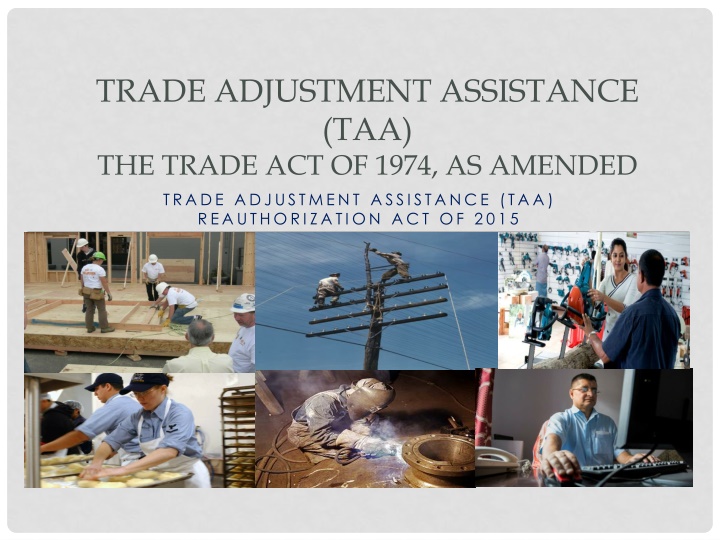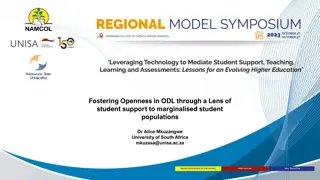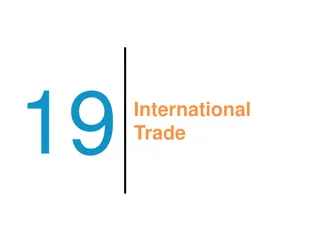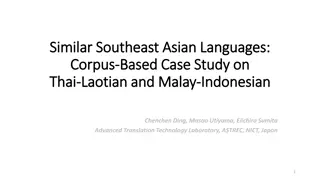Impact of Trade Openness on FDI in Asian Emerging Economies
The impact of trade openness on foreign direct investment (FDI) in Asian emerging economies is explored, highlighting the relationship between trade barriers and FDI inflows. Various studies from different regions provide insights into the causal links and effects of trade policy openness on FDI flows. Understanding these dynamics is crucial for policymakers and businesses operating in these markets.
Download Presentation

Please find below an Image/Link to download the presentation.
The content on the website is provided AS IS for your information and personal use only. It may not be sold, licensed, or shared on other websites without obtaining consent from the author.If you encounter any issues during the download, it is possible that the publisher has removed the file from their server.
You are allowed to download the files provided on this website for personal or commercial use, subject to the condition that they are used lawfully. All files are the property of their respective owners.
The content on the website is provided AS IS for your information and personal use only. It may not be sold, licensed, or shared on other websites without obtaining consent from the author.
E N D
Presentation Transcript
TRADE ADJUSTMENT ASSISTANCE (TAA) THE TRADE ACT OF 1974, AS AMENDED TRADE ADJUSTMENT ASSI STANCE (TAA) REAUTHORI ZATI ON ACT OF 2015
SERVICE ACCESS Before we begin, in order to take advantage of all the services available to you through our American Job Centers, including TAA, you must first create an account in our CTHires database, located at: www.cthires.com So, if you have not done so already, please make sure to go to this site and register!
WHAT IS TAA? TAA=Benefits and Services = Employment and Income 1. TAA (Trade Adjustment Assistance) is a federal program sponsored by the U.S. Department of Labor and is administered by the Connecticut Dept. of Labor for our state. 2. Provides a multitude benefits and services to eligible workers who have lost their jobs due to foreign trade.
THE GOAL OF TAA The goal of the TAA program is to get you back to suitable employment as quickly as possible. Suitable Employment is defined as: Work that is equal to or of a greater skill level of your Trade-impacted job. AND Pays at least 80% of what you were being paid at that job.
WHO IS ELIGIBLE FOR TAA BENEFITS? Any member of a worker group certified in the TAA certification by the US DOL who has experienced a total or partial layoff OR is in danger of being totally or partially laid off
SO, WHAT DOES TAA OFFER? TAA offers a variety of benefits and services to help you become reemployed. They include: Reemployment and case management services Trade Readjustment Allowances (TRA) Job Training Reemployment Trade Adjustment Assistance (RTAA) Job search allowances Relocation allowances Assistance with healthcare premium costs
Lets take a look at these benefits and services!
REEMPLOYMENT SERVICES Comprehensive, specialized career assessments Individualized career counseling Employment planning Resume and interview prep workshops, etc. Supportive services available through the Workforce Innovation and Opportunity Act (WIOA) Employer recruitments Veteran services Resource centers
TRA BENEFITS (TRADE READJUSTMENT ALLOWANCE) Offers financial support you while you are learning Same amount you received while filing for Unemployment (the Weekly Benefit Rate) There are three types of TRA: Basic TRA Additional TRA Completion TRA
To be eligible for TRA you must: Be an adversely affected worker covered under a TAA certification Have a qualifying separation within the impact and termination date of the certification Had at least 26 weeks of employment at wages of $30 or more prior to your layoff The next slide shows what your TRA determination letter looks like and contains important information such as your training enrollment date deadline, the weekly amount of TRA and your Basic TRA eligibility period.
TRA TRAINING ENROLLMENT DEADLINE Highlight Highlight this date, as you need to be enrolled in training prior to this date, as you need to be enrolled in training prior to this this date (or on a date (or on a waiver) In order to waiver) In order to receive receive TRA TRA
THE THREE TYPES OF TRA: Basic TRA Up to 26 weeks of benefits after exhausting regular unemployment insurance benefits Must be participating in full time training, have completed training, or have obtained a waiver of the training requirement with job search efforts Please Note: You may receive basic TRA while conducting work search up to your enrollment date deadline without training or a waiver, but will not be eligible for Additional or Completion TRA.
BASIC TRA JOB SEARCH REQUIREMENTS Follows the same rules as when you were filing for Unemployment benefits 1. Contact at least three employers on two separate days per week 2. Accept any offer of suitable work 3. Consider other types of work 4. Keep a record of your job-seeking efforts
ADDITIONAL TRA UP TO 65 WEEKS Additional TRA is available while you are participating in full time training AND you have exhausted ALL rights to your Basic TRA. . . To remain eligible for Additional TRA, you must continue to be enrolled and participating in training.
COMPLETION TRA PROVIDES ANOTHER 13 WEEKS Payable to you when you exhaust ALL Basic and Additional TRA Five Criteria for Receiving Completion TRA: Requested weeks are necessary to complete training that leads to a degree or industry recognized credential Need to participate in full-time training each week Must meet training benchmarks established in your training plan Continue to make satisfactory progress in training Be on target to complete the training during the established Completion time period 1. 2. 3. 4. 5.
CLAIMS FOR WEEKLY TRA BENEFITS TRA is processed differently than regular UI benefits. They may be mailed, emailed or delivered in person to your TAA representative AND must be accompanied by your training attendance form or Job search efforts form if not in training
WAIVER OF TRAINING A waiver of training allows a participant to receive Basic TRA while not participating in training, but you are required to perform work search efforts. Three Types of Waivers: Health: Unable to participate in training or complete training due to a health condition Enrollment Not Available: Training will not begin within 30 days of the approval date Training Not Available: No training is available in which you can enroll Note: Waivers are only available during Basic TRA. In order to receive Additional or Completion TRA, you MUST be participating in full time training.
WAIVER OF TRAINING REQUIREMENTS A training waiver may be issued if one of the three conditions from the previous page is met Once a waiver of training is approved you will need to fulfill your work search efforts The waiver will be reviewed after the first 90 days and then every 30 days thereafter When the waiver terminates, you will given a new enrollment date deadline for which to enroll in training to remain eligible for TRA
TRAINING Training is available to you either full time or part time, but there is no TRA eligibility with part time. Types of training: Traditional Classroom Training or On-line On-the-Job Training Apprenticeship Programs Post-Secondary Education Certifications Prerequisite and remedial education
YOUR TRAINING PLAN Once you meet with your TAA representative, you will discuss training options best suited for your reemployment goals. There are six criteria for approval: 1. There is NO suitable employment available 2. You would benefit from the training 3. There is a realistic expectation of employment after training 4. The training is reasonably available 5. You are qualified to take and finish the training 6. Training is available at a reasonable cost
WHAT IS IN A TRAINING PLAN? Your training plan will assist you in obtaining the skills necessary to gain suitable employment Components of a training plan Include: Labor Market Data to Support the Training Plan Documented Training Benchmarks reviewed every 60 days Financial Support Projection Training Program Comparisons Course Outline Career Development Plan You will be expected to take and active role in the development of your plan and once started, you are expected to complete the training.
TRAINING ALLOWANCES A cap of $25,300 is allowed for training related costs. Training must be approved BEFORE any expenses will be covered. Subsistence allowance for mileage, food and lodging reimbursement if your training commute is 41 or more miles from your home. There is a maximum of 130 weeks of training allowed. Entitled to one Training program per Trade Act certification. However, a single plan can consist of multiple training components.
INCUMBENT WORKER TRAINING An incumbent worker is still employed, but has been threatened with a separation from their company due to foreign trade TAA training is available while still employed Must be certified as eligible to apply for TAA benefits/services TRA is not available while still employed Re-employment Services available
ON THE JOB TRAINING Allows you to work at a new job while being trained on NEW skills by company Customized to meet the needs of the employer Must apply before starting the new job Can be combined with classroom training if needed Being paid by employer No TRA This is your one and only training plan
APPRENTICESHIP TRAINING Similar to On-The-Job Training Registration with State Apprenticeship Office is required TAA funds can be used to reimburse the employer for costs of training, up to 50% of wages Can be used to cover related instruction costs Being paid by employer No TRA This is your one and only training plan
OCCUPATIONAL TRAINING Can include: Certification programs Associate degrees Bachelor degrees Master degrees Must be able to complete within the 130 week limitation.
REMEDIAL TRAINING GED Basic Adult Education English as a Second Language Remedial training can be combined with occupational training if the total training weeks is 130 or less.
FOLLOWING THE RULES! The Trade program has many great benefits that come with rules and responsibilities You will be provided with documentation detailing there rules and responsibilities You will need to provide grades, progress reports, transcripts and diplomas upon request When in doubt, ask! Don t make any changes before speaking with your TAA representative Failing to comply means you may lose your benefits and possibly be liable to repay money expended on your behalf
RTAA (REEMPLOYMENT TRADE ADJUSTMENT ASSISTANCE) Provides a wage supplement when you are earning less than what you were making at your Trade impacted employer Must be 50, or about to be 50 years of age or older Earn less than $50,000 in your new job Maximum of $10,000 paid to you over a two year period
MORE ABOUT RTAA To receive RTAA you will need to: be fully employed or employed part-time (20+ hours per week) and attending TAA full-time approved training Eligibility period begins when your unemployment benefits have exhausted or when your new job begins, whichever is sooner.
RTAA CONTINUED Cannot receive TRA while receiving RTAA If you collected TRA beforehand, those benefits will be subtracted from the 10,000 cap (eligibility period reduced) Once RTAA is received, you cannot collect any unclaimed TRA
JOB SEARCH ALLOWANCE Covers some of the expenses while looking for work For searches outside of your commuting area (41or more miles one way) There must be a finding of no suitable employment available in your commuting area Covers 90% of the costs for travel and subsistence
JOB SEARCH ALLOWANCE CONTINUED Maximum of $1,250.00 Application for job search allowance must be submitted before job search begins Save all receipts Subject to the limitations of federal per diem rates
RELOCATION ALLOWANCE Must have a bona fide job offer of long-term suitable employment Job offer requires relocation No suitable employment available in your commuting area Covers up to 90% of the expenses that are reasonable and necessary
RELOCATION ALLOWANCE CONTINUED A lump sum payment = to 3x your average weekly wage, UP to $1,250 Application must be submitted before relocation process begins Save all receipts Subject federal per diem rates to limitations
HEALTH COVERAGE TAX CREDIT (HCTC) Available to eligible TAA& RTAA recipients Operated & funded by the Internal Revenue Service Cover 72.5% of you and your family s healthcare insurance premiums if participating in a qualified health care plan as defined by the IRS CTDOL only provides TAA eligibility information to the IRS, we do not determine who is eligible for the credit You will need to fill out forms to enroll, and they can be found on the IRS site at: WWW.IRS.GOV/HCTC
THE END! Thank you for viewing this benefits overview presentation for the TAA program Please make sure you have also read the Participant s Guide to TAA in Connecticut Also please make sure to register in CTHires before your first appointment If you have any questions after reviewing this material, please write then down and ask your TAA representative at your first appointment. https://www.ctdol.state.ct.us/TradeAct























